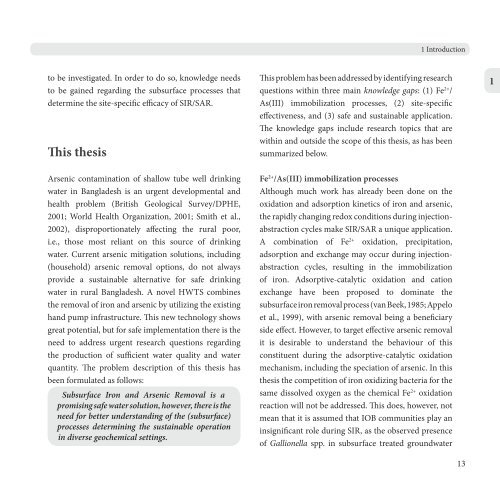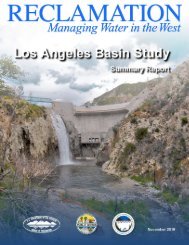Subsurface Iron and Arsenic Removal
qj78kp8
qj78kp8
- No tags were found...
You also want an ePaper? Increase the reach of your titles
YUMPU automatically turns print PDFs into web optimized ePapers that Google loves.
1 Introduction<br />
to be investigated. In order to do so, knowledge needs<br />
to be gained regarding the subsurface processes that<br />
determine the site-specific efficacy of SIR/SAR.<br />
This thesis<br />
<strong>Arsenic</strong> contamination of shallow tube well drinking<br />
water in Bangladesh is an urgent developmental <strong>and</strong><br />
health problem (British Geological Survey/DPHE,<br />
2001; World Health Organization, 2001; Smith et al.,<br />
2002), disproportionately affecting the rural poor,<br />
i.e., those most reliant on this source of drinking<br />
water. Current arsenic mitigation solutions, including<br />
(household) arsenic removal options, do not always<br />
provide a sustainable alternative for safe drinking<br />
water in rural Bangladesh. A novel HWTS combines<br />
the removal of iron <strong>and</strong> arsenic by utilizing the existing<br />
h<strong>and</strong> pump infrastructure. This new technology shows<br />
great potential, but for safe implementation there is the<br />
need to address urgent research questions regarding<br />
the production of sufficient water quality <strong>and</strong> water<br />
quantity. The problem description of this thesis has<br />
been formulated as follows:<br />
<strong>Subsurface</strong> <strong>Iron</strong> <strong>and</strong> <strong>Arsenic</strong> <strong>Removal</strong> is a<br />
promising safe water solution, however, there is the<br />
need for better underst<strong>and</strong>ing of the (subsurface)<br />
processes determining the sustainable operation<br />
in diverse geochemical settings.<br />
This problem has been addressed by identifying research<br />
questions within three main knowledge gaps: (1) Fe 2+ /<br />
As(III) immobilization processes, (2) site-specific<br />
effectiveness, <strong>and</strong> (3) safe <strong>and</strong> sustainable application.<br />
The knowledge gaps include research topics that are<br />
within <strong>and</strong> outside the scope of this thesis, as has been<br />
summarized below.<br />
Fe 2+ /As(III) immobilization processes<br />
Although much work has already been done on the<br />
oxidation <strong>and</strong> adsorption kinetics of iron <strong>and</strong> arsenic,<br />
the rapidly changing redox conditions during injectionabstraction<br />
cycles make SIR/SAR a unique application.<br />
A combination of Fe 2+ oxidation, precipitation,<br />
adsorption <strong>and</strong> exchange may occur during injectionabstraction<br />
cycles, resulting in the immobilization<br />
of iron. Adsorptive-catalytic oxidation <strong>and</strong> cation<br />
exchange have been proposed to dominate the<br />
subsurface iron removal process (van Beek, 1985; Appelo<br />
et al., 1999), with arsenic removal being a beneficiary<br />
side effect. However, to target effective arsenic removal<br />
it is desirable to underst<strong>and</strong> the behaviour of this<br />
constituent during the adsorptive-catalytic oxidation<br />
mechanism, including the speciation of arsenic. In this<br />
thesis the competition of iron oxidizing bacteria for the<br />
same dissolved oxygen as the chemical Fe 2+ oxidation<br />
reaction will not be addressed. This does, however, not<br />
mean that it is assumed that IOB communities play an<br />
insignificant role during SIR, as the observed presence<br />
of Gallionella spp. in subsurface treated groundwater<br />
13<br />
1



